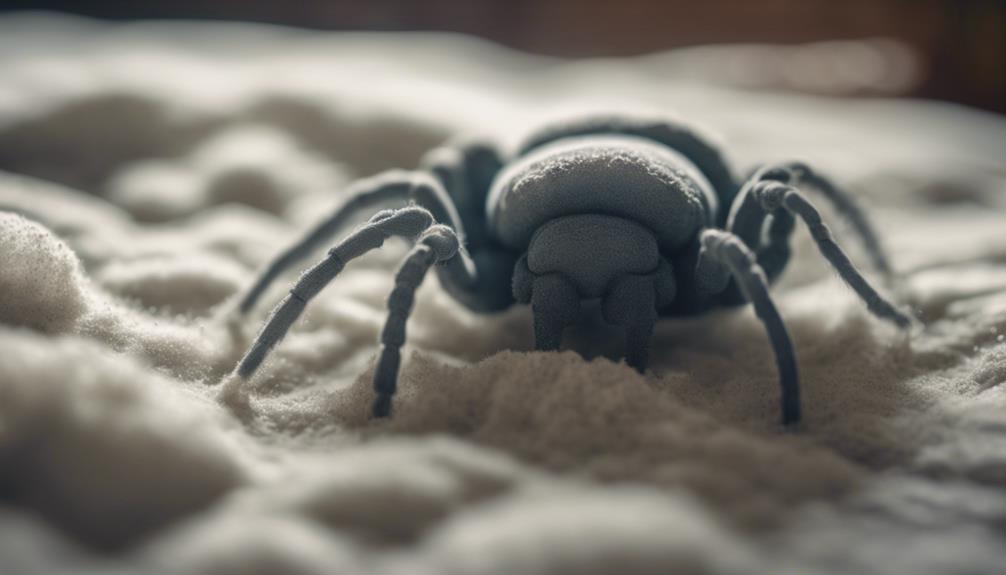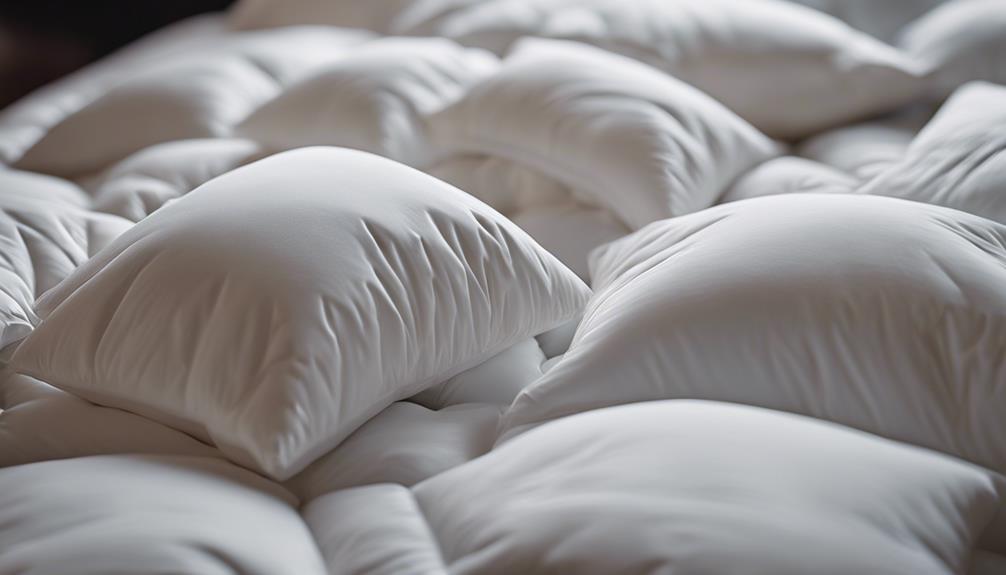Yes, down comforters can cause itching. Dust mites, not feathers, are the main culprits behind allergic reactions. These mites thrive in the warm, humid environment typically found in down comforters. Symptoms may include itching, sneezing, and watery eyes. Regular washing and drying at high heat can help decrease dust mites and alleviate reactions. Choosing hypoallergenic bedding materials such as wool may also reduce itching. Therefore, if you’re questioning the cause of your itchiness, dust mites in down comforters could be the explanation.
Key Takeaways
- Dust mites, not feathers, cause itching in down comforters.
- Allergic reactions are often due to dust mite droppings.
- Regular washing and high-heat drying can reduce itching.
- Opt for hypoallergenic bedding covers and materials.
- Feathers themselves are not the primary allergens.
Allergic Reactions to Down Comforters
When dealing with allergic reactions to down comforters, it's important to understand that the primary culprits are often dust mites rather than the feathers themselves.
Dust mites, microscopic creatures that thrive in warm and humid environments, feed on the dead skin cells that we shed. These pesky critters can be found in many types of bedding, including down comforters filled with feathers.
Allergic reactions to down comforters typically stem from a sensitivity to the proteins found in dust mite droppings rather than the feathers. While true allergies to feathers are rare, the presence of dust mites can trigger symptoms like itching, sneezing, and watery eyes in individuals who are sensitive to these tiny bugs.
Symptoms of Down Feather Allergies

Symptoms of down feather allergies can manifest as itching, often concentrated on areas in direct contact with the comforter. This itching is an important symptom of a feather allergy and can be accompanied by other discomforts like sneezing, coughing, watery eyes, and skin irritation. Allergic reactions to down feathers can vary in intensity, from mild itching to more severe reactions. Itchy eyes may also be a part of the allergic reaction to these feathers. The body's immune response to proteins in the feathers is what typically triggers these symptoms. It is vital to differentiate between itching caused by down feathers and other skin conditions to determine the appropriate treatment.
| Symptom | Description |
|---|---|
| Itching | Common symptom of feather allergy, often on skin in contact with the comforter. |
| Sneezing | Can accompany itching as part of the body's response to the allergens. |
| Watery Eyes | Allergic reaction may lead to itchy and watery eyes, along with other discomforts. |
| Skin Irritation | Some individuals may experience skin irritation as a result of a feather allergy. |
Understanding Dust Mite Allergy in Down Bedding

Dust mites, tiny creatures found in bedding, are the main culprits behind allergic reactions, not the down feathers themselves. These microscopic bugs thrive in warm, moist conditions typical of down comforters, leading to symptoms like itching and skin irritation.
To reduce dust mite presence and alleviate itching, regular washing and high-heat drying of down bedding can be helpful, or opting for hypoallergenic materials like wool may offer a solution.
Dust Mites in Bedding
Understanding the presence of dust mites in down bedding can shed light on the potential triggers for allergic reactions like itching, sneezing, and skin irritation. When it comes to dust mites in bedding, it's crucial to recognize that these tiny creatures thrive in warm and moist environments, making down comforters a cozy home for them. Check out the table below for a quick overview of how dust mites can impact your bedding:
| Keyword | Description |
|---|---|
| Dust | Common trigger for allergic reactions |
| Allergy | Immune response to allergen exposure |
| Feather | Material often found in down bedding |
| Dust Mite | Tiny arachnids causing allergic symptoms |
Allergic Reactions to Down
Upon encountering down comforters, individuals may find themselves experiencing allergic reactions primarily triggered by dust mites rather than the feathers themselves. Dust mites, common in warm, humid environments like bedding, can cause itching and discomfort due to allergic rhinitis. Regularly washing and drying bed linen on high heat can help eliminate dust mites, reducing allergic reactions.
Investing in hypoallergenic materials such as wool can lower the risk of itching from dust mite allergies compared to synthetic materials. Understanding dust mite allergy in down bedding is essential for addressing allergic reactions effectively. By taking steps to reduce dust mites in bedding and choosing hypoallergenic options, individuals can minimize itching and discomfort associated with allergic reactions to down comforters.
Prevention and Treatment
When addressing allergic reactions to down bedding, it's important to focus on prevention and treatment strategies specifically targeting dust mite allergies. Dust mites, rather than feathers, are the main culprit behind allergic reactions in down bedding.
These tiny creatures thrive in the warm, humid environment provided by down comforters. To prevent itching, proper washing and maintenance of down bedding can help eliminate dust mites. Opting for hypoallergenic bedding materials such as wool can also reduce allergic reactions to dust mites in down comforters.
Regularly washing and drying down comforters on high heat can further aid in alleviating itching caused by dust mites. Taking these preventive measures can help individuals with dust mite allergies enjoy a more comfortable sleep environment.
Remedies for Itching Caused by Down Comforters

If you're experiencing itching from your down comforter, there are remedies to help alleviate the discomfort.
One effective solution is to use hypoallergenic bedding covers, which can reduce skin irritation caused by allergens.
Regularly washing and drying your down comforter on high heat can also help eliminate the allergens that may be triggering the itching.
Itching Causes and Prevention
To alleviate itching caused by down comforters, implementing practical solutions like using a duvet cover to create a protective barrier can be highly effective. Itching from down comforters is often triggered by the sharp quills in feathers irritating the skin, especially for allergy sufferers. Common symptoms include redness, irritation, and discomfort.
Regularly washing the down comforter can help remove dust and allergens that contribute to itching. For individuals with sensitive skin or allergies to feathers, opting for hypoallergenic bedding products like down alternative comforters can prevent itching and allergic reactions.
Choosing Hypoallergenic Bedding
Choosing hypoallergenic bedding can greatly alleviate itching caused by down comforters by reducing exposure to allergens. Wool and organic cotton bedding are excellent choices as they're naturally resistant to dust mites, reducing the risk of irritation and itching.
Bamboo Bed is committed to providing quality and sustainable products that cater to individuals prone to allergies. Opting for hypoallergenic materials like wool or organic cotton can create a safer and itch-free sleeping environment. Allergy-causing particles are minimized with these options, ensuring a more comfortable night's rest.
Regularly washing and drying bedding on high heat can further help eliminate allergens that may trigger itching. Making the switch to hypoallergenic bedding can greatly improve sleep quality for allergy-sensitive individuals.
Hypoallergenic Alternatives to Down Comforters

When seeking hypoallergenic alternatives to down comforters, polyester-based down alternative comforters emerge as a suitable choice for individuals with allergies to down feathers. These alternatives are free from common allergens like dust mites and dander, reducing the risk of itching or other allergic reactions. Additionally, down alternative comforters are typically more affordable than real down options while still providing comfort and warmth.
Reviews and feedback from users on platforms like Amazon can help in selecting a high-quality down alternative comforter. Opting for hypoallergenic bedding like down alternative comforters can offer a comfortable and itch-free sleep experience for allergy sufferers. These sustainable products promote a healthier sleep environment by catering to individuals with sensitivities to traditional down bedding materials.
Tips for Managing Allergies to Down Bedding

Regularly washing your bedding covers and pillows is essential for managing allergies to down bedding. Dust mites and mold, not feathers, are the main triggers of allergic reactions. Even hypoallergenic products made of synthetic materials can harbor dust mites if not washed frequently. It's important to recognize that feathers themselves aren't top allergens, but improper cleaning can lead to dust mite buildup, causing allergy symptoms. To prevent these issues, make sure to wash your bedding covers and pillows regularly.
When choosing bedding, consider opting for the latest style in hypoallergenic options to reduce the risk of allergic reactions. These products are designed to minimize allergens and provide a comfortable sleep environment. Additionally, look out for discount codes when purchasing new bedding to save money while prioritizing your health. By staying proactive in cleaning and selecting the right bedding, you can effectively manage allergies to down bedding and enjoy a restful night's sleep.
Frequently Asked Questions
How Can I Tell if I'm Allergic to My Down Comforter?
If you're wondering whether you're allergic to your down comforter, look out for symptoms like itching, redness, or skin irritation. Allergic reactions to down comforters can present as itchiness upon contact.
Consider switching to hypoallergenic bedding if persistent itching occurs. It's important to pay attention to your body's signals when it comes to potential allergies, especially if they're linked to your bedding.
Can Down Feathers Make You Itch?
Yes, down feathers can make you itch, especially if you're sensitive to dust mites or allergens. While the feathers themselves aren't a common direct cause of itching, they can worsen existing allergies.
Opting for hypoallergenic bedding or ensuring regular cleaning of your down comforter can help reduce itching and other allergic reactions. It's important to address any sensitivities to enjoy a more comfortable sleep experience.
Is My Comforter Making Me Itch?
We've looked into whether your comforter might be causing that itch. It's not always the down itself but potentially allergens like dust mites or rough covers causing the irritation.
Regular cleaning and hypoallergenic bedding can help. If the itching persists, swapping to a down alternative or seeking medical advice may be beneficial.
Do Down Comforters Have Dust Mites?
Down comforters can indeed harbor dust mites. These microscopic creatures can trigger allergic reactions, causing itching, sneezing, and skin irritation.
Regularly washing down comforters on high heat can help eliminate dust mites. Opting for hypoallergenic bedding materials may also prevent itching caused by these pests.
It's crucial to maintain cleanliness to reduce the presence of dust mites in down comforters and guarantee a comfortable night's sleep.
Are Down Comforters Likely to Cause Allergic Itching?
Many people wonder if they may be allergic to down comforter. While some individuals are allergic to down feathers, others may be sensitive to dust mites or other allergens that can accumulate in the comforter. It’s best to consult with an allergist to determine if you are allergic to down comforter.
Conclusion
To sum up, while down comforters can cause itching for some individuals due to allergies, there are remedies and hypoallergenic alternatives available.
It's important to understand the symptoms of down feather allergies and how to manage them effectively.
Remember, when it comes to bedding, it's always better to be safe than sorry.
So, make sure to choose the right bedding that suits your needs to avoid any discomfort down the road.









